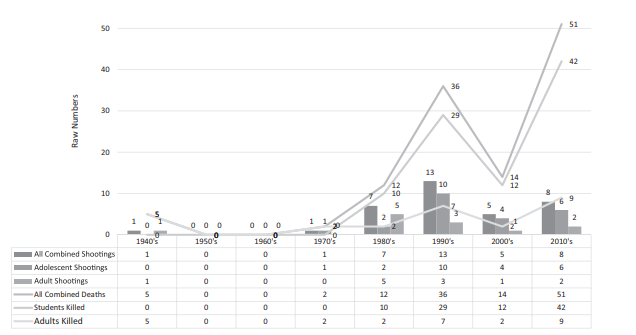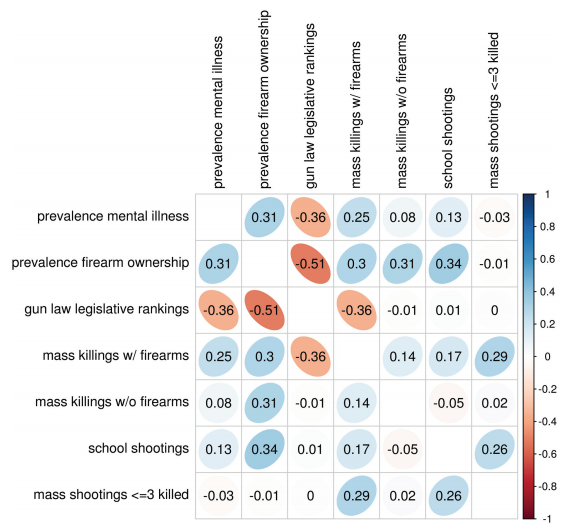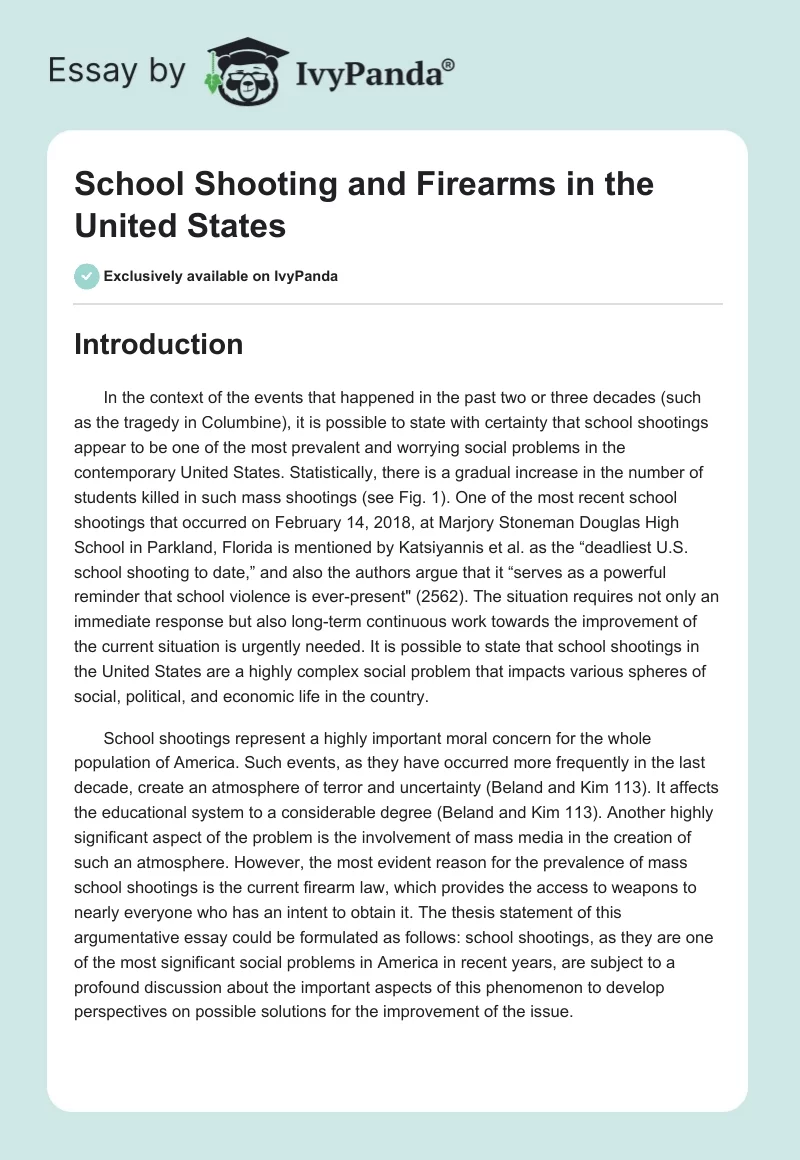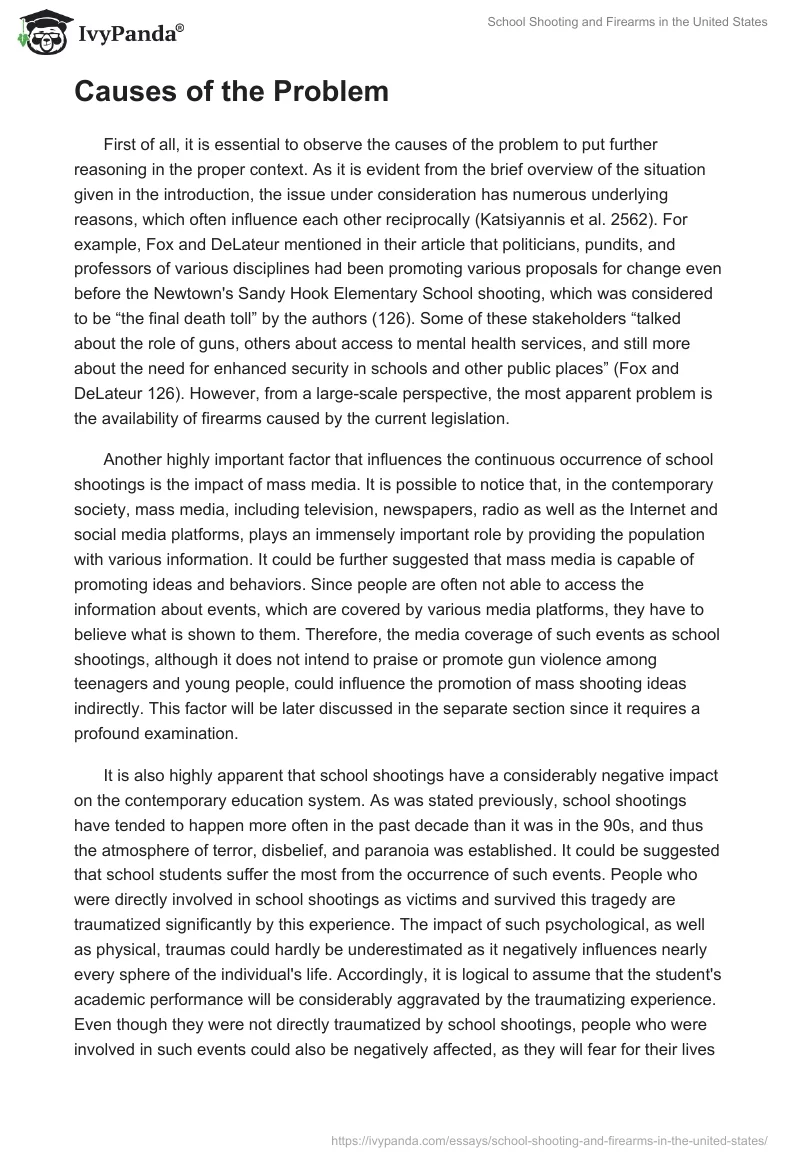Introduction
In the context of the events that happened in the past two or three decades (such as the tragedy in Columbine), it is possible to state with certainty that school shootings appear to be one of the most prevalent and worrying social problems in the contemporary United States. Statistically, there is a gradual increase in the number of students killed in such mass shootings.

One of the most recent school shootings that occurred on February 14, 2018, at Marjory Stoneman Douglas High School in Parkland, Florida is mentioned by Katsiyannis et al. as the “deadliest U.S. school shooting to date,” and also the authors argue that it “serves as a powerful reminder that school violence is ever-present” (2562). The situation requires not only an immediate response but also long-term continuous work towards the improvement of the current situation is urgently needed. It is possible to state that school shootings in the United States are a highly complex social problem that impacts various spheres of social, political, and economic life in the country.
School shootings represent a highly important moral concern for the whole population of America. Such events, as they have occurred more frequently in the last decade, create an atmosphere of terror and uncertainty (Beland and Kim 113). It affects the educational system to a considerable degree (Beland and Kim 113). Another highly significant aspect of the problem is the involvement of mass media in the creation of such an atmosphere.
However, the most evident reason for the prevalence of mass school shootings is the current firearm law, which provides the access to weapons to nearly everyone who has an intent to obtain it. The thesis statement of this argumentative essay could be formulated as follows: school shootings, as they are one of the most significant social problems in America in recent years, are subject to a profound discussion about the important aspects of this phenomenon to develop perspectives on possible solutions for the improvement of the issue.
Causes of the Problem
First of all, it is essential to observe the causes of the problem to put further reasoning in the proper context. As it is evident from the brief overview of the situation given in the introduction, the issue under consideration has numerous underlying reasons, which often influence each other reciprocally (Katsiyannis et al. 2562). For example, Fox and DeLateur mentioned in their article that politicians, pundits, and professors of various disciplines had been promoting various proposals for change even before the Newtown’s Sandy Hook Elementary School shooting, which was considered to be “the final death toll” by the authors (126). Some of these stakeholders “talked about the role of guns, others about access to mental health services, and still more about the need for enhanced security in schools and other public places” (Fox and DeLateur 126). However, from a large-scale perspective, the most apparent problem is the availability of firearms caused by the current legislation.
Another highly important factor that influences the continuous occurrence of school shootings is the impact of mass media. It is possible to notice that, in the contemporary society, mass media, including television, newspapers, radio as well as the Internet and social media platforms, plays an immensely important role by providing the population with various information. It could be further suggested that mass media is capable of promoting ideas and behaviors. Since people are often not able to access the information about events, which are covered by various media platforms, they have to believe what is shown to them. Therefore, the media coverage of such events as school shootings, although it does not intend to praise or promote gun violence among teenagers and young people, could influence the promotion of mass shooting ideas indirectly. This factor will be later discussed in the separate section since it requires a profound examination.
It is also highly apparent that school shootings have a considerably negative impact on the contemporary education system. As was stated previously, school shootings have tended to happen more often in the past decade than it was in the 90s, and thus the atmosphere of terror, disbelief, and paranoia was established. It could be suggested that school students suffer the most from the occurrence of such events. People who were directly involved in school shootings as victims and survived this tragedy are traumatized significantly by this experience. The impact of such psychological, as well as physical, traumas could hardly be underestimated as it negatively influences nearly every sphere of the individual’s life. Accordingly, it is logical to assume that the student’s academic performance will be considerably aggravated by the traumatizing experience. Even though they were not directly traumatized by school shootings, people who were involved in such events could also be negatively affected, as they will fear for their lives or expect one of their classmates to be the next shooter. Therefore, this factor needs an additional investigation in the separate section.
The third factor that should be mentioned in the context of this discussion is the prevalence of mental illnesses and the current state of the United States healthcare system at large. One of the most significant problems in this area of concern is that mental disorders are largely stigmatized by society, especially among the children of school age (Metzl and MacLeish 240). People could be excluded from socializing based on their mental state. It could also be problematic for a teenager to access proper treatment for his or her mental illness, or an individual could consider his or her condition as something that does not need any medical or psychological treatment. Moreover, it is apparent from numerous cases that the majority of people involved in school shootings as shooters have troubles in the sphere of mental health at least to some extent (Metzl and MacLeish 240).
The correlation between the mental state of a person and the probability of him or her being involved in crimes is well-recognized and studied in contemporary academic literature. For example, Metzl and MacLeish assume that psychiatric diagnosis can predict gun crime, and also that school shootings “represent the deranged acts of mentally ill loners” (240). Also, Fox and Fridel mention the following typical characteristics of a mass shooter, which are often disregarded by the society and only come into focus with hindsight: “depression, resentment, social isolation, externalization of blame, fascination with weapons and violent entertainment, and even verbal or written expressions of hate or malice” (14). Therefore, it is essential to notice that people with mental illnesses, even though they should not be automatically considered as potential school shooters, are to be treated with special attention. In the majority of cases, people try to seek help to cope with the stress factors of their life which they do not know how to deal with alone.
At this point, it is evident that the mentioned factor could hardly be adequately estimated, evaluated, and analyzed separately. It is essential to perceive the causes of school shootings as a highly complex set of interdependent reasons that influence each other reciprocally. Therefore, the following sections will attempt to dwell upon the discussion of more particular aspects of the mentioned domains of the overall problem under consideration. Legislations in response to school shootings will be observed in the last part of this essay as they appear to be the key approach to a more stable and adequate situation. Therefore, it is essential to first observe the existing legislative acts, and then to propose possible solutions and improvement for the current situation to develop a comprehensive conclusion.
The Impact of School Shootings on the Education System
As was suggested previously, school shootings could have a vast impact on the academic performance of students and other school-related measures. The study by Beland and Kim is focused on this particular topic, as the authors argue that “the educational consequences of deadly school shootings on enrollment and student performance are not well known” even though this phenomenon is largely covered in media (113). The authors investigate a wide range of aspects that are affected by the occurrence of such events. Among these factors, it is possible to mention the following: enrollment patterns, negative changes in test scores in the subsequent year, as well as behavioral variables such as graduation, attendance, and suspension rates (Beland and Kim 113).
As a result of their study, the authors came to conclusions that are considerably similar to the previously developed premises about the impact of school shootings on the educational system. In general, the authors state that students are directly affected by shootings (Beland and Kim 124). In particular, it is possible to state that math and English standardized test results show a considerable decline after a shooting occurs at a school (Beland and Kim 123). Therefore, the previously formulated assumption about the traumatizing experience that negatively affects the students’ academic performance is true. Also, enrollment patterns change. In schools, which experienced a homicidal mass shooting, the number of people who enroll in Grade 9 drops considerably (Beland and Kim 123). However, the authors did find out that such events have no significant influence on such measures as suspension, graduation, or average daily attendance rates. In general, it is possible to observe that the magnitude of the problem of school shootings is immense.
The Effects of Mass Media Coverage on the Prevalence of School Shootings
In this section, the discussion is largely based on the phenomenon of mass media in the context of its vast impact on the prevalence and, indirectly, the promotion of mass school shootings. Regarding the issue of interest from a broader perspective, it is appropriate to observe that each school shooting is a tragedy, which repeatedly devastates communities and shakes public opinions (Garcia-Bernardo et al. 1). It is also apparent that such events are largely driven by personal intents and motivations, and also rarely there are apparent signals or precursors, and thus it is significantly difficult to predict a school shooting. Nevertheless, the study by Garcia-Bernardo et al. attempts to identify the role of the copycat effect in school shootings as well as the correlation between the amount of information about such an event provided by a mass media platform and the prevalence of the copycat effect.
One of the most principal findings made by Garcia-Bernardo et al. is the significance of the copycat effect in the context of school shootings investigation. As it is mentioned in the article, the interaction between attacks on schools “can be attributed to an acute ‘issue-attention cycle’ with the media reacting strongly to every attack” (Garcia-Bernardo et al. 5). The authors developed their conclusions based on the profound and very inclusive investigation of a large number of tweets since Twitter appears to be one of the most prevalent and diverse social media platforms/mass media. The authors also investigate FBI databases about school shootings. One of the principal findings of the study is that “social media publicity about school shootings correlates with an increase in the probability of new attacks” (Garcia-Bernardo et al. 6). The research is based on the use of a comprehensive mathematical theory, and thus it is possible to state with certainty that the results are reliable.
The Concept of Contagion in the Context of School Shootings
Another concept that should be mentioned in the context of the impact of mass media coverage on the probability of school shootings is contagion. The article by Towers et al. focuses on the implementation of the concept of contagion as a framework for analyzing the phenomenon of school shootings (see Fig. 2). The authors reinforce the findings of the article by Garcia-Bernardo et al., stating that “media reports of suicides and homicides appear to subsequently increase the incidence of similar events in the community” (Towers et al. 1). However, the originality of the approach by Towers et al. is that they use the contagion model to analyze how the occurrence of school shootings increases the probability of a similar event in the immediate future.

The findings of the study by Towers et al., as well as those of the article by Garcia-Bernardo et al., reinforce the assumption which was made in the causes section of this paper. Contemporary mass media appears to be a highly influencing force in terms of spreading ideas and creating a public opinion about various things. In the context of school shootings, Towers et al. suggest that the temporary increase in the probability of another shooting lasts for 13 days on average since the day of the antecedent shooting (1). Therefore, it could be concluded that the spreading of school shooting ideas is considerably similar to the process of contagion.
Legislations in Response to School Shootings
In the final section of the paper before the conclusion, it is essential to overview how the problem of school shootings is responded to by the current legislative acts and what could be possibly done to improve the situation. As it was mentioned several times previously, the importance of gun control is considered to be one of the most important aspects of decreasing the negative impact of mass shootings. This perspective is well-recognized in the contemporary academic literature. For example, studies by Kalesan et al., Katsiyannis et al., as well as Metzl and MacLeish indicate that the existing firearms laws are not significantly efficient in terms of preventing school shootings.
It is possible to assume that one of the most worrying aspects of the current firearm legislation is that there are few attempts to regulate the weapon ownership in households where children or teenagers can access these weapons. As it is mentioned by Schildkraut and Hernandez, Adam Lanza, the Sandy Hook Elementary School shooter, obtained guns that had his mother (359). Other studies also exemplify similar circumstances that preceded other school shootings. Therefore, it is essential to propose that more strict and thorough rules of gun ownership, possession, and storage were created. Another problem, which is mentioned by Vlahov, is that there have been no government-sponsored studies on the issue of mass shootings since 1996 (293). Therefore, it is particularly difficult to estimate the potential efficiency of newly proposed gun laws. Accordingly, it is of high significance to create and promote a community-based and research-based firearm legislation agenda.
However, one of the most effective means of decreasing access to weapons and thus lowering the probability of school shootings is the implementation of background checks for those who wish to purchase weapons. For example, Kalesan et al. state that, as of 2013, only “14 out of the 50 states and District of Columbia had some form of background checks (BCs) for firearm purchase, out of which 5 states required BC for handgun purchases alone but not for long guns or assault weapons” (321). A considerable part of the article by Schildkraut and Hernandez is also dedicated to the discussion of background check legislation. The authors argue that even though such legislation exists, they often do not adequately work (Schildkraut and Hernandez 369). However, it is proven statistically that states with background check laws for firearm and ammunition purchases have lower school shooting incidence rates (Kalesan et al. 326). Therefore, it is essential to implement such legislation.
Conclusion
As to conclude on the conducted analysis, it is essential to restate the immense significance of the problem of school shootings for contemporary America. Considering the thesis statement of this paper, it is possible to extend it by observing that the phenomenon of school shootings is a highly complex set of factors and variables which influence each other reciprocally, and thus it is considerably difficult to predict and prevent such events. Nevertheless, several important arguments could be made to build a comprehensive conclusion on how to decrease the negative impact of the problem under discussion.
First of all, firearm legislation should be changed with the help of the government so that it would be more difficult for teenagers to access various weapons. This aspect of the proposed solution includes the creation of a community and research-based agenda, the implementation of more thorough background checks, and stricter regulation of the conditions of firearm possession. Secondly, it is argued that it is essential to pay more attention to the prevalence of mental illnesses and psychological problems, which are common among school students so that it would be easier to detect some mental health problems that would later lead to another school shooting. Thirdly, the role of mass media, which might increase the probability of a school shooting, should also be considered by policymakers and other stakeholders.
Works Cited
Beland, Louis-Philippe, and Dongwoo Kim. “The Effect of High School Shootings on Schools and Student Performance.” Educational Evaluation and Policy Analysis, vol. 38, no. 1, 2016, pp. 113-126.
Fox, James Alan, and Emma E. Fridel. “The Tenuous Connections Involving Mass Shootings, Mental Illness, and Gun Laws.” Violence and Gender, vol. 3, no. 1, 2016, pp. 14-19.
Fox, James Alan, and Monica J. DeLateur. “Mass Shootings in America: Moving beyond Newtown.” Homicide Studies, vol. 18, no. 1, 2014, pp. 125-145.
Garcia-Bernardo, Javier, et al. “Social Media Affects the Timing, Location, and Severity of School Shootings.” Cornell University Library, Web.
Kalesan, Bindu, et al. “School Shootings during 2013–2015 in the USA.” Injury Prevention, vol. 23, no. 5, 2017, pp. 321-327.
Katsiyannis, Antonis, et al. “Historical Examination of United States Intentional Mass School Shootings in the 20th and 21st Centuries: Implications for Students, Schools, and Society.” Journal of Child and Family Studies, vol. 27, no. 8, 2018, pp. 2562-2573.
Metzl, Jonathan M., and Kenneth T. MacLeish. “Mental Illness, Mass Shootings, and the Politics of American Firearms.” American Journal of Public Health, vol. 105, no. 2, 2015, pp. 240-249.
Schildkraut, Jaclyn, and Tiffany Cox Hernandez. “Laws that Bit the Bullet: A Review of Legislative Responses to School Shootings.” American Journal of Criminal Justice, vol. 39, no. 2, 2014, pp. 358-374.
Towers, Sherry, et al. “Contagion in Mass Killings and School Shootings.” PLoS One, vol. 10, no. 7, 2015, pp. 1-12.
Vlahov, David. “Building the Evidence Base to Prevent Firearm Deaths and Injuries.” Journal of Urban Health, vol. 95, no. 3, 2018, pp. 293-294.


